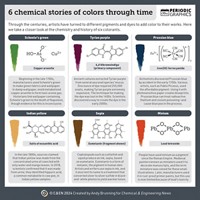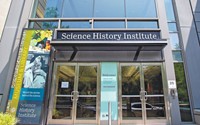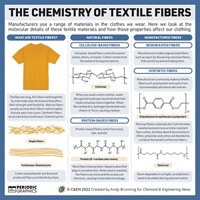Advertisement
Grab your lab coat. Let's get started
Welcome!
Welcome!
Create an account below to get 6 C&EN articles per month, receive newsletters and more - all free.
It seems this is your first time logging in online. Please enter the following information to continue.
As an ACS member you automatically get access to this site. All we need is few more details to create your reading experience.
Not you? Sign in with a different account.
Not you? Sign in with a different account.
ERROR 1
ERROR 1
ERROR 2
ERROR 2
ERROR 2
ERROR 2
ERROR 2
Password and Confirm password must match.
If you have an ACS member number, please enter it here so we can link this account to your membership. (optional)
ERROR 2
ACS values your privacy. By submitting your information, you are gaining access to C&EN and subscribing to our weekly newsletter. We use the information you provide to make your reading experience better, and we will never sell your data to third party members.
Environment
Perspectives: The intertwined histories of chemistry, fashion, and advertising
Archival materials provide a rich resource for investigating connections between chemistry and design
by Stephanie E. Vasko, Toolbox Dialogue Initiative, Michigan State University
August 7, 2017
| A version of this story appeared in
Volume 95, Issue 32

When thinking about the intersection of chemistry and design, many chemists might first envision the design of molecules or industrial processes. Stepping back to view the bigger picture, however, reveals that the interplay of innovations in chemistry and the design of physical objects are more deeply ingrained in our daily lives than it might seem.
Exploring the chemistry-design intersection of fibers in our clothing, fiber treatments such as dyeing, and fashion, for example, not only illustrates the history, technology development, and impacts of innovation, but also hints at how studying interesting (and perhaps underexamined) stories could lead to thinking ahead about social responsibility and about innovations in both the chemistry and design fields.
Deciphering the intertwined histories of chemistry and fashion design requires an interdisciplinary approach. This includes studying the archival records of synthetic fibers and their design applications, discussions between fiber producers and the fashion industry, advertisements to the public and to design-related industries, adjacent industries in the chemistry-design nexus such as the dye industry and the life cycle of synthetics and their impacts on the environment.
These explorations have inspired museum exhibitions such as “The Secret Life of Textiles: Synthetic Materials” at New York City’s Metropolitan Museum of Art (on view until Sept. 4). This exhibit highlights the physical properties of objects, with a focus on potential problems stemming from the degradation of plastic fibers in garments.
Previous exhibitions include “Second Skin: The Science of Stretch” at the Chemical Heritage Foundation in Philadelphia, which depicted the use of stretch fabrics. Another is “Color Revolution: Style Meets Science in the 1960s” at the now-defunct American Textile History Museum in Lowell, Mass. It focused on post-World War II America and “explored the new dyes, fibers, and designs … and helped visitors understand how technology and design support each other.”
My interest in the intersection of chemistry and design focuses on chemical innovations and advertising. After completing a Ph.D. in chemistry and nanotechnology at the University of Washington in 2012, I attended the History of Modern Design National Endowment for the Humanities SummerInstitute at Drexel University in 2015. This formal training added to what I would say is my own unique personal perspective on the topic. I grew up in northwest New Jersey, near sites for large chemical manufacturers such as BASF and J.T. Baker, and when my parents took my family to yard sales or auctions, I remember going through old magazines and ephemera. These experiences inspired and continue to inspire my investigations into history, place, and ephemera as related to the chemistry-design intersection.
Inspired to learn more, I obtained an exploratory research grant that I used last year to examine synthetic fibers and innovation using archival materials at the Hagley Museum & Library in Wilmington, Del. This project introduced me to the idea of using trade publications to explore the historical dimension of chemistry and design.
According to the University of Michigan’s Andrew J. Hoffman, a business scholar focusing on natural resources management, trade journals act as a historical record as perceived from within an industry, as well as of the motivating factors behind industry actions. Analyzing the advertisements in trade journals provides a means to question how a product or innovation was advertised, the audience for the advertisement, and the effects of those advertisements on the target audience.
At Hagley, I examined the collection of issues of American Fabrics (later American Fabrics & Fashion), a magazine published from the mid-1940s to the mid-1980s by William Segal. According to Segal’s obituary in the New York Times in 2000, American Fabrics was “a magazine that quickly became the bible of the garment trade at a time when the American textile industry was entering a new era with the growing use of synthetic fabrics like nylon, rayon and polyester.”
American Fabrics featured advertisements and articles from chemical companies and dye works, and news updates on styles, manufacturing, and fashion. At the time, magazines such as C&EN and other trade journals were also running advertisements for synthetic fiber and dye manufacturers and dye plants, but with content and style suited to each publication’s particular audience. These advertisements provide a fascinating window into how industries at the synthetic fiber-fashion interface communicated with the public and with other industries, and they can be used to examine the history of individual companies and innovations.
As highlighted by the American Textile History Museum’s “Color Revolution” exhibit, the synthetic fiber and dye industries grew after World War II, thanks to consumer desire alongside innovations in chemistry and chemical production. One example of this growth is the dyestuffs plant in Toms River, N.J., built in the early 1950s by Ciba, one of the leading dye manufacturers at the time.
During my research, I was immediately struck by a series of extremely positive advertisements in American Fabrics from Ciba updating readers on construction of the Toms River plant. These ads focus on several themes, such as the modernity of Ciba’s process and the company’s desire to be a local and national partner. One advertisement, titled “Progress Report 3,” is an excellent example of Ciba’s use of text and imagery to make these themes come alive. Phrases such as “most modern plant of its kind” and “a good neighbor rather than a strange bedfellow to the community” are juxtaposed with local imagery, healthy environments, and happy citizens.
Unfortunately, the Toms River plant was plagued by pollution problems and placed on the Superfund National Priorities List in 1983. Ciba’s notorious environmental legacy and potential role in a suspected cancer cluster gained renewed attention in 2013 through Dan Fagin’s Pulitzer Prize-winning book, “Toms River: A Story of Science and Salvation.”
When the plant opened, Ciba received press coverage in C&EN on its water-treatment plant and its dyestuffs production. These articles did not escape Fagin’s research. Former C&EN editor-in-chief Rudy M. Baum wrote a review of Fagin’s book, stating, “C&EN even makes its own sad little appearance in ‘Toms River.’ ” Baum’s review includes an image of a 1953 C&EN article with a caption noting, “C&EN bought into Ciba’s false claims that effluent from its Toms River dyestuffs plant would be harmless to the environment.”
I am still working toward adding to the history and legacy of Ciba through a detailed textual and visual analysis of its American Fabrics advertisements. There’s no shortage of fascinating chemistry-design intersections like the Toms River story to investigate. My hope is that sharing these connections will help chemists and designers learn from the past and shape a collaborative future, as well as inspire others to investigate chemistry and design intersections that pique their interests.
Stephanie E. Vasko is a research associate and the program manager for the Toolbox Dialogue Initiative at Michigan State University, a research effort focused on aiding cross-disciplinary groups in fields including sustainability and campus planning to enhance their communication and collaborative capacity. Vasko is also a 2017 AAAS Community Engagement Fellow.
Learn how to write for C&EN Perspectives. Submit your ideas to cenperspectives@acs.org.






Join the conversation
Contact the reporter
Submit a Letter to the Editor for publication
Engage with us on Twitter